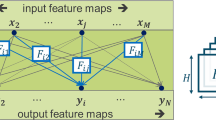Abstract
Deep convolutional neural networks (DCNNs) have shown outstanding performance in the fields of computer vision, natural language processing, and complex system analysis. With the improvement of performance with deeper layers, DCNNs incur higher computational complexity and larger storage requirement, making it extremely difficult to deploy DCNNs on resource-limited embedded systems (such as mobile devices or Internet of Things devices). Network quantization efficiently reduces storage space required by DCNNs. However, the performance of DCNNs often drops rapidly as the quantization bit reduces. In this article, we propose a space efficient quantization scheme which uses eight or less bits to represent the original 32-bit weights. We adopt singular value decomposition (SVD) method to decrease the parameter size of fully-connected layers for further compression. Additionally, we propose a weight clipping method based on dynamic boundary to improve the performance when using lower precision. Experimental results demonstrate that our approach can achieve up to approximately 14x compression while preserving almost the same accuracy compared with the full-precision models. The proposed weight clipping method can also significantly improve the performance of DCNNs when lower precision is required.
Similar content being viewed by others
References
Krizhevsky A, Sutskever I, Hinton G E. ImageNet classification with deep convolutional neural networks. In Proc. the 26th Annual Conf. Neural Information Processing Systems, December 2012, pp.1106-1114.
Ren S, He K, Girshick R, Sun J. Faster R-CNN: Towards real-time object detection with region proposal networks. In Proc. the 29th Annual Conf. Neural Information Processing Systems, December 2015, pp.91-99.
Abdel-Hamid O, Mohamed A R, Jiang H, Deng L, Penn G, Yu D. Convolutional neural networks for speech recognition. IEEE/ACM Trans. Audio, Speech, and Language processing, 2014, 22(10): 1533-1545.
Mao H, Alizadeh M, Menache I, Kandula S. Resource management with deep reinforcement learning. In Proc. the 15th ACM Workshop on Hot Topics in Networks, November 2016, pp.50-56.
Deng J, Dong W, Socher R, Li L J, Li K, Li F F. ImageNet: A large-scale hierarchical image database. In Proc. the 2009 IEEE Computer Society Conf. Computer Vision and Pattern Recognition, June 2009, pp.248-255.
He K, Shang X, Ren S, Sun J. Deep residual learning for image recognition. In Proc. IEEE Conf. Computer Vision and Pattern Recognition, June 2016, pp.770-778.
Yao S, Hu S, Zhao Y, Zhang A, Abdelzaher T. DeepSense: A unified deep learning framework for time-series mobile sensing data processing. In Proc. the 26th International Conference on World Wide Web, April 2017, pp.351-360.
Guo B, Wang Z, Yu Z, Wang Y, Yen N, Huang R, Zhou X. Mobile crowd sensing and computing: The review of an emerging human-powered sensing paradigm. ACM Computing Surveys, 2015, 48(1): Article No. 7.
Vanhoucke V, Senior A, Mao M Z. Improving the speed of neural networks on CPUs. In Proc. NIPS Deep Learning and Unsupervised Feature Learning Workshop, December 2011, pp.611-620.
Han S, Mao H, Dally W J. Deep compression: Compressing deep neural networks with pruning, trained quantization and Huffman coding. In Proc. Int. Conf. Learning Representations, May 2016, pp.351-360.
Gysel P, Motamedi M, Ghiasi S. Hardware-oriented approximation of convolutional neural networks. arXiv:1604.03168, 2016. https://arxiv.org/abs/1604.03168, October 2018.
Simonyan K, Zisserman A. Very deep convolutional networks for large-scale image recognition. arXiv:1409.1556, 2014. https://arxiv.org/abs/1409.1556, April 2018.
Chen W, Wilson J T, Tyree S, Weinberger K Q, Chen Y. Compressing neural networks with the hashing trick. In Proc. the 32nd Int. Conf. Machine Learning, July 2015, pp.2285-2294.
Wu J, Leng C, Wang Y, Hu Q, Cheng J. Quantized convolutional neural networks for mobile devices. In Proc. the 2016 IEEE Conf. Computer Vision and Pattern Recognition, June 2016, pp.4820-4828.
Zhou A, Yao A, Guo Y, Xu L, Chen Y. Incremental network quantization: Towards lossless CNNs with low precision weights. arXiv:1702.03044, 2017. https://arxiv.org/abs/1702.03044, August 2017.
Park E, Ahn J, Yoo S. Weighted-entropy-based quantization for deep neural networks. In Proc. the 2017 IEEE Conf. Computer Vision and Pattern Recognition, July 2017, pp.7197-7205.
Jaderberg M, Vedaldi A, Zisserman A. Speeding up convolutional neural networks with low rank expansions. In Proc. British Machine Vision Conference, September 2014, Article No. 73.
Hinton G, Vinyals O, Dean J. Distilling the knowledge in a neural network. arXiv:1503.02531, 2015. https://arxiv.org/pdf/1503.02531.pdf, November 2018.
Iandola F N, Han S, Moskewicz M W, Ashraf A, Dally W J, Keutzer K. SqueezeNet: AlexNet-level accuracy with 50x fewer parameters and <0.5 MB model size. arXiv:1602.07360, 2016. https://arxiv.org/abs/1602.07360, November 2018.
Chollet F. Xception: Deep learning with depthwise separable convolutions. In Proc. the 2017 IEEE Conf. Computer Vision and Pattern Recognition, July 2017, pp.1800-1807.
Lin D, Talathi S, Annapureddy S. Fixed point quantization of deep convolutional networks. In Proc. the 33rd Int. Conf. Machine Learning, Jun. 2016, pp.2849-2858.
Gupta S, Argawal A, Gopalakrishnan K, Narayanan P. Deep learning with limited numerical precision. In Proc. the 32nd Int. Conf. Machine Learning, July 2015, pp.1737-1746.
Gong Y, Liu L, Yang M., Bourdev L. Compressing deep convolutional networks using vector quantization. arXiv:1412.6115, 2014. https://arxiv.org/abs/1412.6115, December 2018.
Kullback S, Leibler R A. On information and sufficiency. The Annals of Mathematical Statistics, 1951, 22(1): 79-86.
Abadi M, Barham P, Chen J, Chen Z et al. TensorFlow: A system for large-scale machine learning. In Proc. the 12th USENIX Symposium on Operating Systems Design and Implementation, November 2016, pp.265-283.
Author information
Authors and Affiliations
Corresponding authors
Electronic supplementary material
ESM 1
(PDF 327 kb)
Rights and permissions
About this article
Cite this article
Zhao, DD., Li, F., Sharif, K. et al. Space Efficient Quantization for Deep Convolutional Neural Networks. J. Comput. Sci. Technol. 34, 305–317 (2019). https://doi.org/10.1007/s11390-019-1912-1
Received:
Revised:
Published:
Issue Date:
DOI: https://doi.org/10.1007/s11390-019-1912-1




